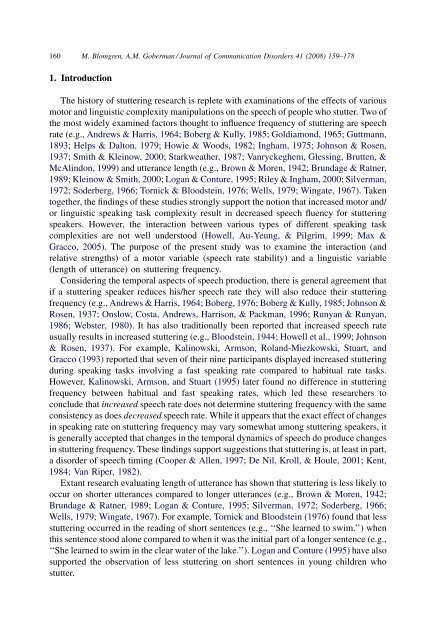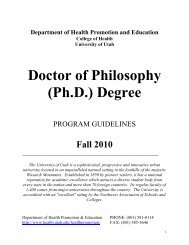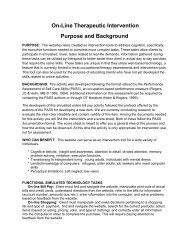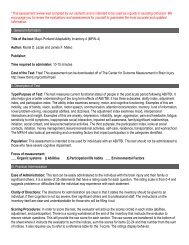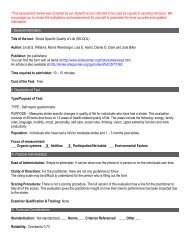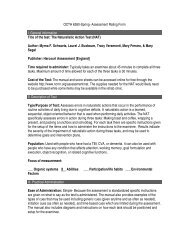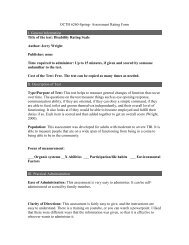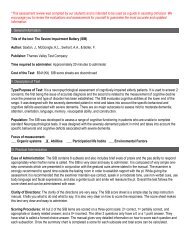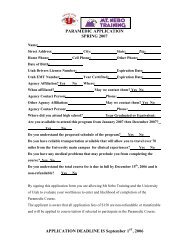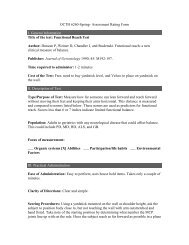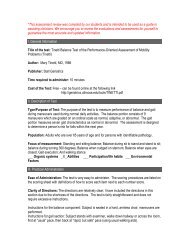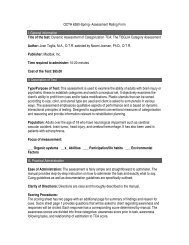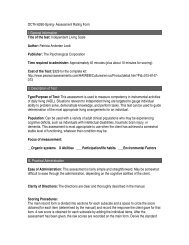Revisiting speech rate and utterance length ... - ResearchGate
Revisiting speech rate and utterance length ... - ResearchGate
Revisiting speech rate and utterance length ... - ResearchGate
Create successful ePaper yourself
Turn your PDF publications into a flip-book with our unique Google optimized e-Paper software.
160M. Blomgren, A.M. Goberman / Journal of Communication Disorders 41 (2008) 159–1781. IntroductionThe history of stuttering research is replete with examinations of the effects of variousmotor <strong>and</strong> linguistic complexity manipulations on the <strong>speech</strong> of people who stutter. Two ofthe most widely examined factors thought to influence frequency of stuttering are <strong>speech</strong><strong>rate</strong> (e.g., Andrews & Harris, 1964; Boberg & Kully, 1985; Goldiamond, 1965; Guttmann,1893; Helps & Dalton, 1979; Howie & Woods, 1982; Ingham, 1975; Johnson & Rosen,1937; Smith & Kleinow, 2000; Starkweather, 1987; Vanryckeghem, Glessing, Brutten, &McAlindon, 1999) <strong>and</strong> <strong>utterance</strong> <strong>length</strong> (e.g., Brown & Moren, 1942; Brundage & Ratner,1989; Kleinow & Smith, 2000; Logan & Conture, 1995; Riley & Ingham, 2000; Silverman,1972; Soderberg, 1966; Tornick & Bloodstein, 1976; Wells, 1979; Wingate, 1967). Takentogether, the findings of these studies strongly support the notion that increased motor <strong>and</strong>/or linguistic speaking task complexity result in decreased <strong>speech</strong> fluency for stutteringspeakers. However, the interaction between various types of different speaking taskcomplexities are not well understood (Howell, Au-Yeung, & Pilgrim, 1999; Max &Gracco, 2005). The purpose of the present study was to examine the interaction (<strong>and</strong>relative strengths) of a motor variable (<strong>speech</strong> <strong>rate</strong> stability) <strong>and</strong> a linguistic variable(<strong>length</strong> of <strong>utterance</strong>) on stuttering frequency.Considering the temporal aspects of <strong>speech</strong> production, there is general agreement thatif a stuttering speaker reduces his/her <strong>speech</strong> <strong>rate</strong> they will also reduce their stutteringfrequency (e.g., Andrews & Harris, 1964; Boberg, 1976; Boberg & Kully, 1985; Johnson &Rosen, 1937; Onslow, Costa, Andrews, Harrison, & Packman, 1996; Runyan & Runyan,1986; Webster, 1980). It has also traditionally been reported that increased <strong>speech</strong> <strong>rate</strong>usually results in increased stuttering (e.g., Bloodstein, 1944; Howell et al., 1999; Johnson& Rosen, 1937). For example, Kalinowski, Armson, Rol<strong>and</strong>-Miezkowski, Stuart, <strong>and</strong>Gracco (1993) reported that seven of their nine participants displayed increased stutteringduring speaking tasks involving a fast speaking <strong>rate</strong> compared to habitual <strong>rate</strong> tasks.However, Kalinowski, Armson, <strong>and</strong> Stuart (1995) later found no difference in stutteringfrequency between habitual <strong>and</strong> fast speaking <strong>rate</strong>s, which led these researchers toconclude that increased <strong>speech</strong> <strong>rate</strong> does not determine stuttering frequency with the sameconsistency as does decreased <strong>speech</strong> <strong>rate</strong>. While it appears that the exact effect of changesin speaking <strong>rate</strong> on stuttering frequency may vary somewhat among stuttering speakers, itis generally accepted that changes in the temporal dynamics of <strong>speech</strong> do produce changesin stuttering frequency. These findings support suggestions that stuttering is, at least in part,a disorder of <strong>speech</strong> timing (Cooper & Allen, 1997; De Nil, Kroll, & Houle, 2001; Kent,1984; Van Riper, 1982).Extant research evaluating <strong>length</strong> of <strong>utterance</strong> has shown that stuttering is less likely tooccur on shorter <strong>utterance</strong>s compared to longer <strong>utterance</strong>s (e.g., Brown & Moren, 1942;Brundage & Ratner, 1989; Logan & Conture, 1995; Silverman, 1972; Soderberg, 1966;Wells, 1979; Wingate, 1967). For example, Tornick <strong>and</strong> Bloodstein (1976) found that lessstuttering occurred in the reading of short sentences (e.g., ‘‘She learned to swim.’’) whenthis sentence stood alone compared to when it was the initial part of a longer sentence (e.g.,‘‘She learned to swim in the clear water of the lake.’’). Logan <strong>and</strong> Conture (1995) have alsosupported the observation of less stuttering on short sentences in young children whostutter.


